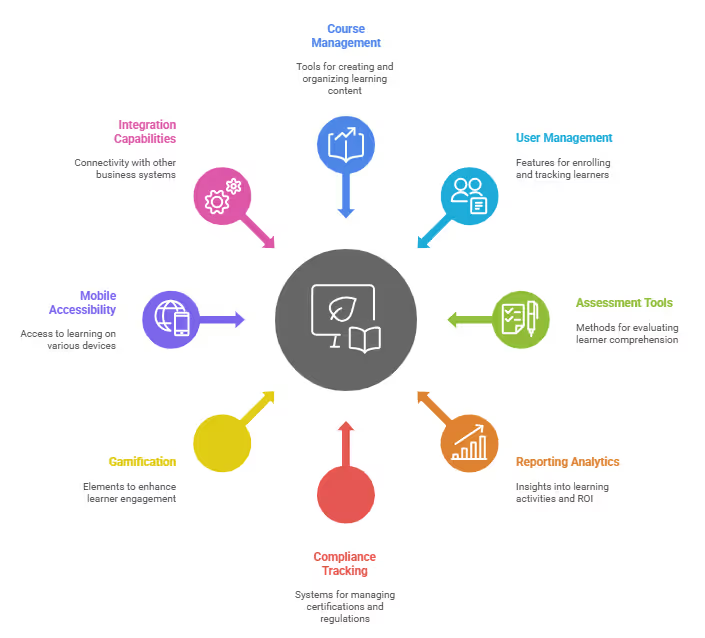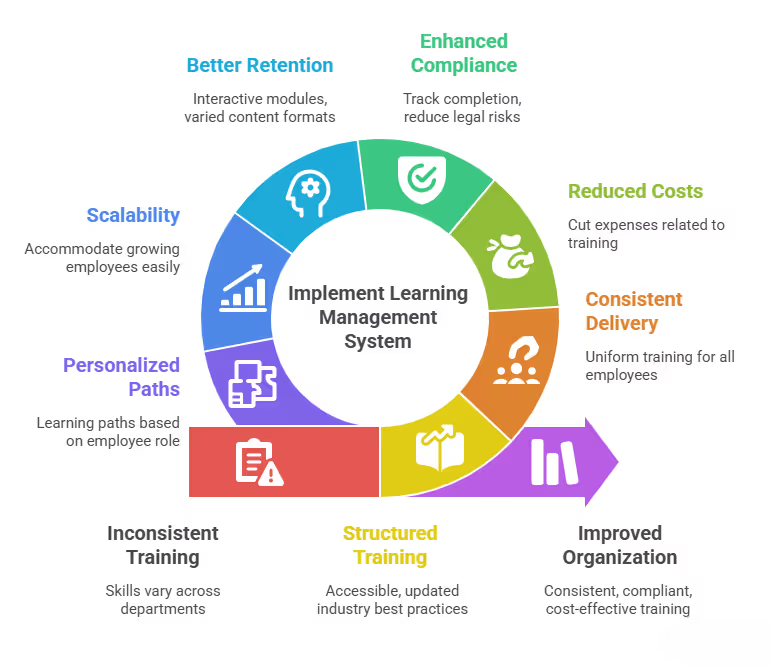LMS vs HRMS – Key Differences and Use Cases

LMS vs HRMS: Your Guide to Choosing Software
As a software development company that has worked on numerous HR and learning solutions over the past 5+ years, we have seen firsthand the pivotal role technology plays in shaping modern workplaces. Especially in the competitive landscape of the United States, businesses constantly seek an edge in managing their most valuable asset: their people. Two terms that often come up in these discussions are Learning Management Systems (LMS) and Human Resource Management Systems (HRMS). While both are crucial for optimizing workforce operations, they serve distinct purposes, and understanding their differences is key to making the right investment for your organization.
In the U.S. market, where employee development and talent retention are paramount, choosing between or integrating these systems can significantly impact operational efficiency, compliance, and employee satisfaction.
This comprehensive guide will break down what an LMS and an HRMS are, their core functionalities, their unique benefits, and ultimately, how to determine which solution, or combination thereof, best fits your strategic goals for your U.S. business.
An LMS focuses on employee training and development, while an HRMS centralizes all core human resources administrative functions, from payroll to employee data management for your U.S. operations.
LMS and HRMS Defined for U.S. Businesses

What is an LMS (Learning Management System)?
An LMS is a software application designed specifically for the administration, documentation, tracking, reporting, automation, and delivery of educational courses, training programs, or learning and development programs. Think of it as your company's digital classroom and training hub.
From an organizational perspective, particularly for U.S. companies aiming for continuous upskilling and compliance, an LMS is indispensable. It streamlines how employees access learning materials, complete assessments, and track their progress. For instance, a manufacturing firm in Ohio might use an LMS to onboard new factory floor workers with safety training modules, while a tech startup in Silicon Valley could leverage it for ongoing professional development in new programming languages.
What is an HRMS (Human Resource Management System)?
An HRMS, also often referred to as a Human Resources Information System (HRIS) or Human Capital Management (HCM) system, is a broader software solution that integrates various human resources functions into a single platform. It acts as the central nervous system for all HR-related data and processes within your organization.
For businesses across the United States, an HRMS automates and manages core HR tasks, reducing manual paperwork and improving data accuracy. This includes everything from hiring and onboarding to payroll processing, benefits administration, time and attendance tracking, and performance management. A healthcare provider in Texas, for example, uses an HRMS to manage employee records, ensure accurate payroll for its diverse staff, and administer complex benefits packages.
LMS vs HRMS Features
To truly grasp the distinction between an LMS and an HRMS, we need to delve into their primary features.
While there can be some overlap, their core capabilities serve different strategic HR objectives.
Key Features of a Learning Management System (LMS) for U.S. Workforces
An effective LMS provides tools that facilitate a comprehensive learning ecosystem.
For businesses in the U.S., these features are critical for fostering a skilled and adaptable workforce.

- Course Creation and Management: This is the heart of any LMS. It allows administrators to create, upload, organize, and manage various types of learning content, including videos, documents, quizzes, and interactive modules. Many modern LMS platforms offer drag-and-drop interfaces and reusable content blocks, simplifying the process.
- User Management: Administrators can enroll users, assign roles (e.g., learner, instructor, administrator), track individual and group progress, and manage learning paths. This is particularly useful for large U.S. corporations with diverse departments and training needs.
- Assessment and Evaluation: Beyond just delivering content, an LMS enables the creation of quizzes, exams, and surveys to assess learner comprehension and gather feedback. This data is vital for gauging the effectiveness of training programs.
- Reporting and Analytics: A robust LMS offers detailed insights into learning activities. Metrics like course completion rates, scores, time spent on modules, and learner engagement help HR and L&D teams in the U.S. understand training ROI and identify skill gaps.
- Certification and Compliance Tracking: For industries with strict regulatory requirements in the U.S., such as finance or pharmaceuticals, an LMS tracks mandatory certifications, manages renewal reminders, and generates audit-ready reports, ensuring compliance.
- Gamification and Engagement Tools: To make learning more appealing, many LMS solutions incorporate gamification elements like badges, leaderboards, and points. Social learning features, such as discussion forums and peer-to-peer communication, also foster a collaborative environment.
- Mobile Accessibility: With a significant portion of the U.S. workforce being mobile or remote, an LMS must be accessible across various devices, allowing employees to learn anytime, anywhere.
- Integration Capabilities: A good LMS can integrate with other business systems, most notably HRMS, but also with CRMs, single sign-on (SSO) solutions, and content repositories.
Key Features of a Human Resource Management System (HRMS) for U.S. Companies
An HRMS consolidates the administrative backbone of HR operations. For any organization in the United States, an efficient HRMS is fundamental for compliance, accurate record-keeping, and streamlined HR workflows.
- Employee Data Management: This centralizes all employee information, from personal details and contact information to job history, performance reviews, and compensation data. This single source of truth is invaluable for U.S. companies managing large workforces.
- Payroll Processing: One of the most critical HR functions, an HRMS automates salary calculations, tax withholdings, deductions, and direct deposits. This is vital for ensuring accurate and timely payments, especially with the complex tax regulations in different U.S. states.
- Benefits Administration: Managing health insurance, retirement plans (like 401(k)s), paid time off (PTO), and other employee benefits can be complex. An HRMS simplifies enrollment, tracking, and compliance with benefit regulations.
- Time and Attendance Management: This feature tracks employee work hours, absences, leave requests, and overtime, often integrating with time clocks or mobile applications. For businesses with hourly employees in the U.S., this ensures accurate payroll and compliance with labor laws.
- Recruitment and Onboarding: An HRMS often includes applicant tracking systems (ATS) to manage job postings, applications, interviews, and candidate communication. Once hired, it facilitates smooth onboarding processes, including digital paperwork and new hire checklists.
- Performance Management: This module helps set goals, track performance, conduct reviews, and manage feedback cycles. For U.S. companies focused on talent development, this can include 360-degree feedback, performance appraisals, and goal setting.
- Compliance Management: Given the intricate labor laws and regulations in the United States, an HRMS helps ensure adherence to federal, state, and local requirements, such as EEOC compliance, FMLA tracking, and OSHA reporting.
- Self-Service Portals: Both employees and managers can access relevant information (e.g., pay stubs, benefits details, leave balances) and complete certain tasks (e.g., requesting time off, updating personal information), reducing the administrative burden on HR staff.
Distinct Benefits: Why Each System Matters for U.S. Businesses
While both systems contribute to overall organizational health, their unique benefits cater to different strategic priorities.
Understanding these can help U.S. businesses prioritize their software investments.
Benefits of a Learning Management System (LMS) for U.S. Organizations

An LMS provides tangible advantages directly related to talent development, knowledge retention, and compliance.
- Improved Employee Skills and Performance: By providing structured and accessible training, an LMS helps employees acquire new skills, improve existing ones, and stay updated with industry best practices. This directly impacts productivity and service quality in U.S. businesses.
- Consistent Training Delivery: An LMS ensures that all employees receive uniform training, regardless of their location or department. This is particularly beneficial for U.S. companies with geographically dispersed teams, ensuring a consistent message and standard of knowledge.
- Reduced Training Costs: Moving from traditional, in-person training to online modules via an LMS can significantly cut down on expenses related to travel, venues, instructors, and printed materials.
- Enhanced Compliance and Risk Mitigation: For industries with mandatory training requirements (e.g., cybersecurity awareness for financial institutions in New York, or food safety for hospitality in Florida), an LMS meticulously tracks completion, making it easy to prove compliance during audits and reducing legal risks.
- Better Knowledge Retention: Interactive modules, spaced repetition, and varied content formats offered by an LMS can lead to higher knowledge retention compared to passive learning methods.
- Scalability for Growth: As a U.S. company expands, an LMS can easily scale to accommodate a growing number of employees and diverse training needs without a proportional increase in administrative effort.
- Personalized Learning Paths: Many modern LMS platforms allow for personalized learning paths based on an employee's role, performance, or identified skill gaps, fostering more relevant and engaging development.
Benefits of a Human Resource Management System (HRMS) for U.S. Companies
An HRMS delivers critical administrative efficiencies, enhances data accuracy, and supports strategic workforce planning.
- Streamlined HR Operations: By automating routine tasks like payroll processing, benefits enrollment, and time tracking, an HRMS frees up HR professionals to focus on more strategic initiatives, such as talent development and employee engagement.
- Improved Data Accuracy and Accessibility: A centralized database eliminates data silos and reduces manual entry errors, ensuring consistent and accurate employee information across all HR functions. This is crucial for accurate reporting and decision-making in any U.S. organization.
- Enhanced Compliance and Reduced Legal Risk: An HRMS helps U.S. businesses navigate complex labor laws, tax regulations, and reporting requirements, significantly reducing the risk of penalties and lawsuits related to non-compliance.
- Better Employee Experience and Engagement: Employee self-service portals empower employees to access their information, manage benefits, and submit requests, leading to greater transparency and satisfaction. This also improves communication between employees and HR.
- Strategic Workforce Planning: With comprehensive data on talent, performance, and attrition, an HRMS provides valuable insights for strategic workforce planning, helping U.S. companies identify future staffing needs, skills gaps, and retention strategies.
- Cost Savings through Efficiency: Automation and reduced administrative overhead can lead to significant cost savings in HR departments, optimizing resource allocation.
- Improved Recruitment and Onboarding: An integrated ATS within an HRMS can speed up the hiring process, improve candidate quality, and ensure a consistent and positive onboarding experience for new hires in the U.S.
LMS vs. HRMS: A Comparative Table for U.S. Business Needs
To further clarify the distinctions, here's a direct comparison of a Learning Management System and a Human Resource Management System.
Deciding Your Path: LMS, HRMS, or Both for Your U.S. Company?
The decision of whether to implement an LMS, an HRMS, or an integrated solution largely depends on your organization's specific needs, size, industry, and strategic priorities.
For U.S. businesses, this choice often reflects the balance between operational efficiency and long-term talent development.
When an LMS is the Priority for Your U.S. Business
Consider an LMS first if your primary challenges revolve around:
- Employee Skill Gaps: You need a systematic way to identify and address skill deficiencies across your workforce.
- Compliance Training: Your industry has strict regulatory training requirements (e.g., healthcare, finance, manufacturing in the U.S.) that demand rigorous tracking and reporting.
- Onboarding Efficiency: You want to standardize and streamline the new hire training process to get employees up to speed faster.
- Scalable Learning: You have a growing workforce or diverse teams requiring accessible and consistent training across different locations in the U.S.
- Knowledge Management: You need a centralized repository for company-specific knowledge, procedures, and best practices.
When an HRMS is the Priority for Your U.S. Business
An HRMS should be your focus if your most pressing needs are:
- Administrative Overload: Your HR team is bogged down by manual paperwork, disparate systems, and inefficient processes for payroll, benefits, or employee records.
- Payroll Accuracy and Compliance: Ensuring accurate, timely payroll and navigating complex U.S. state and federal tax laws is a major challenge.
- Employee Data Centralization: You lack a single, reliable source for all employee information, leading to inconsistencies and reporting difficulties.
- Improved Employee Experience: You want to empower employees with self-service options and streamline common HR requests.
- Recruitment and Onboarding Management: You need to improve the efficiency and effectiveness of your hiring and initial onboarding processes.
The Power of Integration: LMS and HRMS Working Together for U.S. Growth
For many growing and established businesses in the United States, the ideal solution isn't one or the other, but a strategic integration of both. This approach leverages the strengths of each system, creating a holistic human capital management ecosystem.
Integrating an LMS with an HRMS provides numerous advantages:
- Seamless Employee Data Sync: When new employees are hired via the HRMS, their data can automatically flow into the LMS, eliminating manual entry and ensuring they are enrolled in necessary onboarding or compliance training. Similarly, an employee's promotion or role change in the HRMS can trigger new training assignments in the LMS.
- Holistic Talent Insights: Combining learning data with core HR data allows for a more comprehensive view of an employee's journey. You can link training completion to performance reviews, identify skill gaps impacting productivity, and even analyze the ROI of training initiatives. For U.S. companies focused on data-driven HR, this is invaluable.
- Automated Workflows: Automation can extend beyond just data sync. For example, if an employee completes a specific certification in the LMS, it can automatically update their record in the HRMS, or trigger a performance review.
- Enhanced Employee Experience: Employees benefit from a unified portal where they can access both their HR information (pay stubs, benefits) and their learning resources (training modules, development plans) without switching between multiple systems. This creates a more intuitive and user-friendly experience, vital for retention in the competitive U.S. job market.
- Improved Compliance and Reporting: With integrated data, demonstrating compliance becomes easier. For instance, you can quickly generate reports showing that all employees in a certain department in California have completed their mandatory harassment prevention training, with records updated automatically from the LMS to the HRMS.
Many leading HR software providers in the U.S. now offer integrated HRMS and LMS modules or seamless integration capabilities through APIs, recognizing the growing demand for unified solutions. Companies like Workday, ADP, and SAP SuccessFactors offer comprehensive HCM suites that often include strong learning components.
Market Trends and Considerations for U.S. Businesses
The HR and learning technology markets in the United States are dynamic, driven by factors like remote work, AI integration, and the ongoing demand for continuous upskilling.
Current Market Trends in U.S. HR Tech
- Cloud-Based Solutions: The shift to cloud-based LMS and HRMS platforms continues to accelerate in the U.S. Cloud solutions offer scalability, accessibility, reduced IT overhead, and faster deployment.
- AI and Machine Learning Integration: Both LMS and HRMS platforms are increasingly leveraging AI for personalized learning recommendations, predictive analytics for talent management, automated HR tasks, and AI-powered chatbots for employee support. This is particularly prevalent in the innovative U.S. tech sector.
- Mobile-First Approach: Given the prevalence of mobile devices, vendors prioritize mobile-responsive designs and dedicated apps for both learning and HR self-service, catering to the on-the-go U.S. workforce.
- Focus on Employee Experience (EX): Beyond mere functionality, both systems evolve to offer intuitive, engaging user interfaces that prioritize the employee's journey, from seamless onboarding to personalized learning and easy access to HR information.
- Data Analytics and Reporting: There's a growing emphasis on robust analytics and reporting capabilities to help U.S. businesses make data-driven decisions about their workforce, training effectiveness, and HR strategy.
- Compliance Automation: With evolving labor laws in the U.S., both systems enhance features to automate compliance checks, generate necessary reports, and keep up with regulatory changes.
Choosing a Vendor in the United States for LMS or HRMS
When evaluating LMS or HRMS vendors for your U.S.-based operations, consider the following:
- Scalability: Can the system grow with your company, accommodating more users and complex requirements?
- Integration Capabilities: How well does it integrate with your existing tech stack, especially if you plan to integrate an LMS and HRMS? Look for robust APIs.
- Customization: Can the platform be tailored to your specific organizational structure, workflows, and branding?
- User Experience (UX): Is it intuitive and easy for both HR staff and employees to use? A poor UX can hinder adoption.
- Security and Compliance: Does the vendor meet U.S. data privacy standards (e.g., CCPA for California businesses) and industry-specific regulations?
- Support and Training: What kind of customer support, training, and implementation assistance does the vendor offer?
- Cost: Beyond the licensing fees, consider implementation costs, ongoing maintenance, and potential future upgrades.
Top LMS Providers in the U.S. (Examples): Cornerstone OnDemand, TalentLMS, Absorb LMS, Docebo, Blackboard, Articulate Rise.
Top HRMS Providers in the U.S. (Examples): Workday, ADP Workforce Now, Rippling, BambooHR, SAP SuccessFactors, UKG, Gusto.

